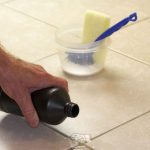Want to upgrade your home’s style? Grout and silicone internal corners are the perfect solution.
These materials provide a seamless finish that can be used in both traditional and contemporary designs. Plus, they’re easy to install and maintain.
So, if you’re looking for a quick way to spruce up the interior design of your home, consider grout and silicone internal corners.
They will add sophistication while lasting for years with little maintenance.
Contents
- 1 What is Grout?
- 2 What is Silicone?
- 3 Advantages and Disadvantages of Using Grout for Internal Corners
- 4 Advantages and Disadvantages of Using Silicone for Internal Corners
- 5 How to Grout Inside Corners
- 6 Do You Grout or Caulk Inside Corners?
- 7 Should I Use Silicone or Grout in Shower Corners?
- 8 How Do You Finish Internal Tile Corners?
- 9 Conclusion
What is Grout?
Grout is an essential part of any tiling project. It’s made of sand, water, and cement and comes in a variety of colors, textures, and sizes.
Grout is used to fill the gaps between tiles in bathrooms, kitchens, patios, decks, and more. Not only does it provide protection from water damage and dirt, but it also helps maintain the overall look of your tile installation.
With the correct application techniques, grout can last for years without needing to be replaced.
So if you’re looking to add some style to your home or outdoor space with tile work, don’t forget about grout! It’s a great way to make sure that your project looks perfect for years to come.
What is Silicone?
Are you looking for a waterproof sealant to use in wet or damp environments? Look no further than silicone! This synthetic polymer is highly resistant to water and temperature fluctuations, making it perfect for areas with moisture.
Plus, it comes in a variety of colors, so you can find the perfect match for your project.
Applying silicone is easy—just use a caulk gun or brush to fill gaps between tiles and other surfaces, creating a strong and durable waterproof seal.
So if you’re looking for an adhesive, sealant, or lubricant that won’t let you down, trust silicone!
Advantages and Disadvantages of Using Grout for Internal Corners
Grout is a great choice for tiling internal corners. It’s cheaper than silicone, provides a strong and durable seal, and is easy to apply. Plus, it comes in a variety of colors to match your tiles.
But grout does have some drawbacks.
Over time, it can shrink and leave gaps that need to be filled again. If not applied properly or exposed to too much water or humidity, it can crack or break. And it requires regular maintenance and cleaning to keep it looking good.
If you’re looking for an affordable way to tile your internal corners, grout is a great option.
Advantages and Disadvantages of Using Silicone for Internal Corners
Are you looking for an easy and effective way to protect your internal corners from water damage and mold? Silicone is a great option.
It’s simpler to apply than grout, takes less time, and is waterproof and mold-resistant. Plus, it comes in a variety of colors to match the tile or grout.
But there are some downsides to using silicone for internal corners. It can be hard to remove if you want to replace or repair tiles in the future.
It also tends to be more expensive than grout and can discolor over time due to exposure to water and other elements.
Lastly, if not applied correctly, it can crack or peel away from the surface.
If you decide that silicone is the right choice for your project, make sure you take your time when applying it so that it will last for years.
How to Grout Inside Corners
Tackling tricky inside corners can be a daunting task. But with the right tools and a few simple steps, you can do it like a pro! Here’s what you need: grout float, a bucket of clean water, and a sponge.
Start by removing any old grout from the corner with a scraper. Then use the grout float to spread the grout evenly into the corner. After that, use a damp sponge to wipe away any excess grout.
Remember to rinse off your tools with clean water after each use! Once you’re done, let the grout dry overnight before applying sealer or caulk. Now you’re ready to tackle those tricky inside corners like an expert.
Do You Grout or Caulk Inside Corners?
Grouting and caulking are essential for any home renovation project. Grout is the best choice for inside corners, as it creates a strong, water-resistant seal. Use a float to evenly apply the grout and get into all the crevices. Once finished, apply a grout sealer to protect it from stains and moisture.
Caulk should only be used in drywall corners or around windows and doors where there is no risk of water damage. Before applying caulk, make sure to clean the area first and let it dry before painting or sealing it.
Follow these tips when grouting or caulking your next home project to ensure that your work lasts for years!
Should I Use Silicone or Grout in Shower Corners?
Are you looking to give your shower corners a makeover? You have two great options: silicone or grout. Silicone is waterproof and resistant to mold and mildew, plus it’s easy to apply and won’t crack over time.
Grout can be more aesthetically pleasing but needs to be sealed regularly for protection.
When deciding between the two, think about the type of tile you’re using, the level of maintenance required, and the desired look.
If you want a quick fix with minimal upkeep, opt for silicone. If you’re after a more attractive finish, use both silicone and grout together. No matter what you choose, your shower corners will look amazing.
How Do You Finish Internal Tile Corners?
Are you looking for the perfect way to finish your internal tile corners? Whether it’s grout, caulk, or silicone, there is a material that can suit your needs.
Grout is best for large gaps between tiles as it provides a strong bond and adds to the aesthetic. Caulk is better for smaller gaps as it offers a flexible seal that can withstand movement. Silicone is ideal for wet areas such as showers, as it’s waterproof and mold-resistant.
Before applying any material to the internal corner, make sure to clean the area with a damp cloth or sponge. Use a putty knife or other tool to spread grout or caulk evenly and fill any gaps. Non-sanded grout or caulk will give you the best results. Allow the material to dry completely before using the area again.
Finishing your internal tile corner doesn’t have to be difficult! With these tips in mind, you can find the perfect material for your project and get it done quickly and easily.
Conclusion
Grout and silicone internal corners can help you upgrade your home.
Both materials provide a strong, long-lasting seal that needs minimal maintenance.
Grout is great for large gaps between tiles, while silicone is best for wet areas like showers. Caulk should only be used in drywall corners or around windows and doors.
With the right tools and easy steps, you can apply these materials like a pro.
So don’t wait—give your home an interior design boost today!





